
Published
3 seconds ago
on
April 3, 2024
| 2 views
-->
By
Chris Dickert
Graphics & Design
- Athul Alexander
The following content is sponsored by Hive Digital
GPUs and High-Performance Computing
Graphics Processing Units, or GPUs, have moved beyond their original role of rendering video game graphics and are now used in a variety of high-performance computing applications (HPC), from AI training to zooplankton classification.
To help understand this pivot, we’ve teamed up with HIVE Digital to look at how GPUs differ from traditional CPUs and what gives them an edge.
CPU vs. GPUs
CPUs, or Central Processing Units, and GPUs, generally have three main elements:
- compute elements—technically ALU or arithmetic logic units—that perform calculations and carry out operations;
- a control element that coordinates the operations of the above; and
- various levels of memory, including dynamic random access memory (DRAM), a kind of RAM or short-term memory used in the main memory of computers, and caches.
CPUs, or Central Processing Units, typically have one or more extremely powerful cores, made up of independent compute, control, and cache elements. A GPU, on the other hand, has many more less-powerful cores, each with multiple ALUs that share common cache and control elements.
Core Values and the Value of Cores
The number of cores is important, especially when it comes to image processing. In order to display an image on your screen, the computer has to read, process, and display data for each pixel, which on modern high-definition displays can really add up. A 1,920 by 1,080 pixel display, for example, has 2,073,600 pixels.
Unlike CPUs, which have to go one operation at a time, GPUs can handle multiple operations like this in parallel, thanks to its multiple-core architecture. Computer scientists call this method of data-handling single instruction, multiple data (SIMD), but all we need to know is that this is why today’s computer games look so much better than 1972’s Pong.
Beyond Graphics
It turns out that GPUs can do more than just render graphics. Researchers are now using GPUs to model protein folding and sequence genomes, while cryptocurrency miners rely on them to validate transactions. GPUs are also playing a critical role in the field of AI, where training datasets are only getting larger.
GPUs are also working side-by-side with CPUs in the world’s only exa-scale computer, Frontier, which uses a combined 8,699,904 GPU and CPU cores to achieve an impressive speed of 1.194 exa-flops per second.
But when you consider that CPUs are still built on roughly the same von Neumann architecture from 1945, it’s perhaps no surprise that new specialized designs, like the GPU, are emerging to help us tackle some of the world’s toughest HPC challenges.

Learn how Hive Digital’s renewably powered GPUs are helping customers worldwide meet their high-performance computing needs.

Please enable JavaScript in your browser to complete this form.Enjoying the data visualization above? *Subscribe
Related Topics: #artificial intelligence #GPU #hivedigital #Pong #CPU #high-performance computing
Click for Comments
var disqus_shortname = "visualcapitalist.disqus.com";
var disqus_title = "How GPUs are Disrupting High-Performance Computing";
var disqus_url = "https://www.visualcapitalist.com/sp/gpus-v-cpus/";
var disqus_identifier = "visualcapitalist.disqus.com-165673";
You may also like
-

Technology2 days ago
Visualizing Nvidia’s Revenue, by Product Line (2019-2024)
This graphic shows how Nvidia’s revenue sources have changed over time, highlighting how the AI boom has transformed its bottom line.
-

Technology6 days ago
Visualizing Internet Usage by Global Region
In this infographic, we map out internet usage by global region based on the latest data from the World Bank.
-

Technology7 days ago
Mapped: Internet Download Speeds by Region
North America and East Asia have the speediest internet.
-

Technology2 weeks ago
The World’s Biggest Cloud Computing Service Providers
Cloud computing service providers generated $270 billion in revenues last year, concentrated among a few giants.
-

Technology2 weeks ago
The World’s Largest Corporate Holders of Bitcoin
From MicroStrategy to Tesla, this graphic shows who holds the most bitcoins globally across corporate companies.
-

AI2 weeks ago
Charted: The Jobs Most Impacted by AI
We visualized the results of an analysis by the World Economic Forum, which uncovered the jobs most impacted by AI.
Subscribe
Please enable JavaScript in your browser to complete this form.Join the 375,000+ subscribers who receive our daily email *Sign Up
The post How GPUs are Disrupting High-Performance Computing appeared first on Visual Capitalist.